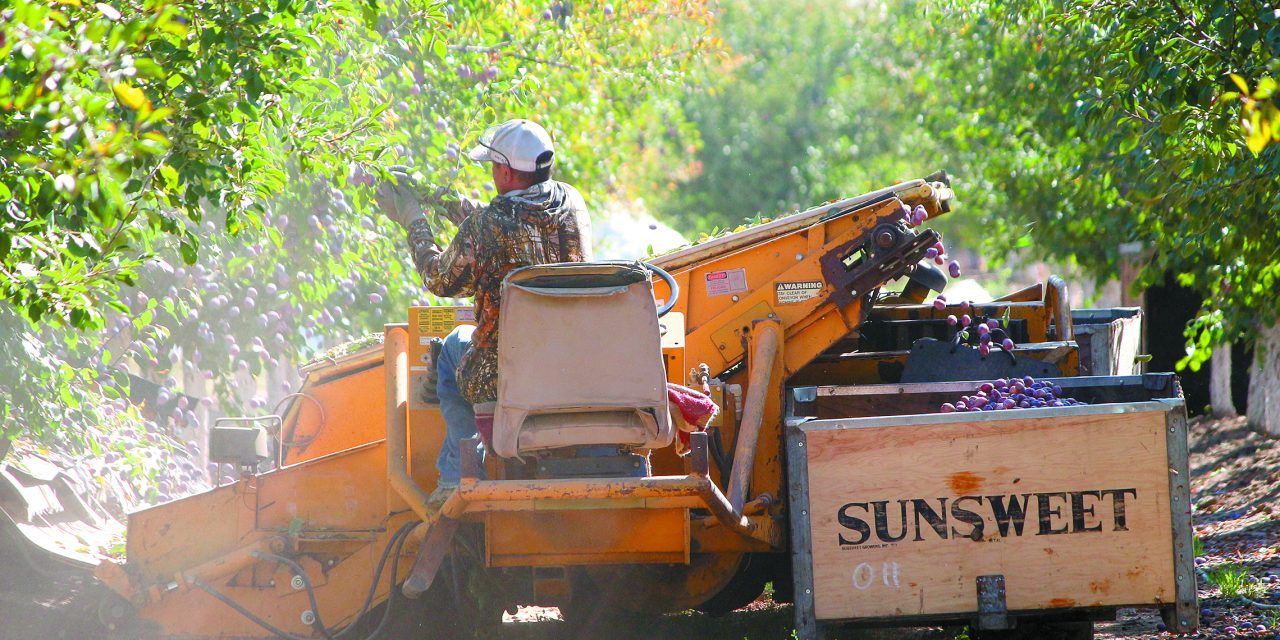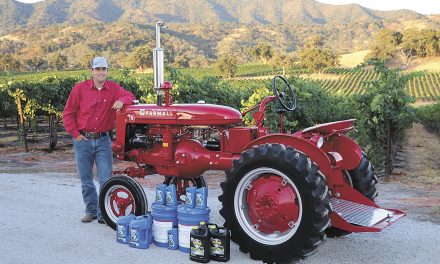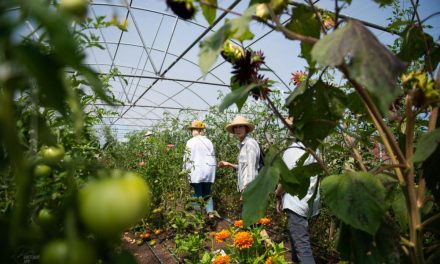As price of almonds and walnuts goes down in recent years, growers remove more of those trees for prunes
By Ching Lee
California Farm Bureau Federation
CALIFORNIA — Now that California prune growers are earning a higher price for their crop, with supply more in line with demand, marketers of the dried fruit have a message for them: Don’t go nuts on prunes.
The warning comes as the price of almonds and walnuts has trended down in recent years and growers remove more of those trees. People in the prune business are concerned that farmers looking to replace their nut orchards will overplant prunes.
Yolo County grower Joe Turkovich put it more bluntly: “The point is don’t destroy this industry like you’ve done the others.”
The concerns are understandable, as it was not so long ago that the prune sector faced a “chronic overhang of fruit” it couldn’t sell, which led to depressed prices and growers removing acres, he said.
A walnut grower himself, Turkovich is also pulling out an orchard, “but that doesn’t mean I’m filling that space with prunes,” he said.
Unlike the growth seen in almonds, walnuts, and pistachios, Turkovich said the prune business remains “more of a boutique industry” with demand that has stayed relatively flat through the years.
Whereas farmers treated tree nuts “like the Wild West, just planting everywhere and worrying about it later,” prunes are “a totally different game,” he said. The crop is more sensitive to overplanting, as it doesn’t take “many extra new acres to disrupt the supply-demand balance,” he added.
John Taylor of Taylor Brothers Farms, a prune grower and processor in Sutter County, said adding another 5,000 acres could throw the supply-demand balance “out of whack.” He said the industry has done well marketing 80,000 to 100,000 tons. Once production gets above that, “I think we’ll have some problems.”
“We’re really nervous that people that have taken out all their walnuts will start planting (prunes), which would be upsetting, because the industry can only handle so much as far as saleable tonnage,” Taylor said.
Thanks to depleted inventory, the price of prunes has improved over what it had been five years ago — and growers want to keep it that way, Turkovich said.
He noted that as a grower-member of Sunsweet, he must first get approval from the cooperative’s management and board of directors to plant more acres. Even some walnut packers are now becoming more strategic about managing supply and production, such as by “telling growers we don’t want your old varieties anymore,” he said.
For those thinking about getting into prunes or adding more acreage, Turkovich said farmers should first consult with their packer rather than planting without a contract. Planting speculatively now and then looking for a buyer when the trees come into production is a “recipe for disaster,” he warned.
“On the one hand, we’re happy that we have a real stable industry,” Turkovich said. “But on the other hand, we know how easy it is to mess it up because we’ve had 20 years of that experience with oversupply.”
California prune plantings have been steadily dropping during the past 20-plus years. State bearing acreage stood at 86,000 in 2000, according to the U.S. Department of Agriculture. There were 35,000 bearing acres last year, with another 7,000 acres of newly planted trees, according to the California Prune Board.
Donn Zea, the board’s executive director, said the industry would not want acreage to drop below its current level, “and we don’t think that’s going to happen.” He said there has been “significant emphasis” on balancing state inventory, acreage and production with what marketers can ship.
“We need to remain very thoughtful and sober about how many trees go in the ground because markets ebb and flow,” he said. “We don’t need to chase production and ultimately drive price down.
“Said another way: Don’t rush to plant new prune acres but let demand pull through additional supply as we continue to build off a few strong years,” Zea added.
He described the sector as being in “a pretty good spot,” with positive signs that it is “reinvesting for the long term.”
Armed with more scientific research about the health benefits of prunes — including how it can maintain good gut health and may prevent bone loss — Zea said he thinks the industry is in a good position to take advantage of current trends that emphasize food as medicine. No longer is the sector running from the fruit’s long-known effectiveness in relieving constipation. It is now embracing it while also trying to broaden the product’s appeal with younger consumers by promoting prunes as “more than just laxation,” he said.
“We believe there’s a renaissance going on with a lot of healthy foods, and prunes are right up there at the top,” Zea said.
He noted how the industry began seeing “real market improvement” beginning in the fall 2019 with increased shipments of California prunes. During the height of the pandemic when other agricultural sectors were negatively affected by food-service shutdowns, the prune business boomed, Zea said, as consumers loaded pantries and bought more nutritious packaged foods.
Short crops during the past two years in other prune-producing regions such as South America and France also boosted sales of California prunes, he said. Though some of the sales uptick has subsided, particularly in export markets, Zea said domestic demand remains strong.
“We believe we captured some new customers,” Zea said, adding the prune board has been trying to build on the pandemic-related market surge, though current economic headwinds make it challenging because California prunes command a premium price compared to product from Chile, the state’s main competitor.
The California crop is estimated at 75,000 to 80,000 tons this year, with harvest nearing completion this week or next week.
Grower Turkovich described the quality of his crop as “excellent, real clean, with no insect damage or other defects.” He said his yields are moderate to good, noting that a hot spell in mid-June caused a lot of sun scorch on his fruit, with likely losses totaling 15 percent to 20 percent of his potential production.
With total world prune consumption at around 200,000 tons, Zea said if California ships 80,000 to 90,000 tons, carryover inventory could drop to 20,000 tons, which he characterized as too little. Ideally, there should be at least 40,000 tons in reserve, he said.
But with Chile’s big crop last year and decent production expected in France this year, Zea said global inventories might start to bump up again. Even so, he said he expects the state’s inventory to remain relatively tight, considering continued strong U.S. demand for prunes.
“We’re going to do everything we can to make sure that we can mitigate that supply issue from getting back to where it was a few years ago,” he said.
Feature Image: Prunes are harvested from an orchard in Winters. After years of removing acreage, California prune growers have found their market sweet spot. With prunes earning a higher price in recent years, they now fear there will be a rush to plant more fruit, upsetting the supply-demand balance. Photo courtesy of Ching Lee
















